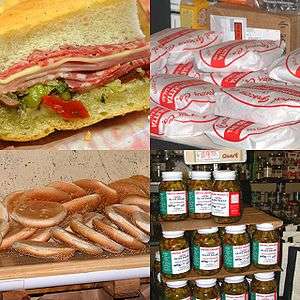Muffuletta
The muffuletta is both a type of round Sicilian sesame bread[1] and a popular sandwich that originated among Italian immigrants in New Orleans, Louisiana, using the same bread.
 From top left, clockwise: muffuletta cross section, muffuletta in wrappers, muffuletta-style olive salad, circular muffuletta loaves | |
| Course | Main course |
|---|---|
| Place of origin | Italy (bread) United States (sandwich) |
| Region or state | Sicily New Orleans |
| Main ingredients | Bread: Wheat flour, water, eggs, olive oil, yeast, salt, sugar Sandwich: marinated muffuletta-style olive salad, layers of mortadella, salami, Swiss cheese, ham, provolone |
History
The muffuletta bread has origins in Sicily,[2] most commonly eaten on All Souls' Day.[3]
The muffuletta sandwich is said to be created in 1906 at Central Grocery Co. on Decatur Street, New Orleans, Louisiana, U.S., by its delicatessen owner Salvatore Lupo, a Sicilian immigrant.[4][5] Another Italian-style New Orleans delicatessen, Progress Grocery Co., originally opened in 1924 by the Perrone family, claims the origin of the muffuletta is uncertain.[6]
The traditional-style muffuletta sandwich consists of a muffuletta loaf[7] split horizontally and covered with layers of marinated muffuletta-style olive salad,[8] salami, ham, Swiss cheese, provolone, and mortadella.[9] Quarter, half, and full-sized muffulettas are sold.[10][11]
The signature olive salad consists of olives diced with the celery, cauliflower and carrot found in a jar of giardiniera, seasoned with oregano and garlic, covered in olive oil, and allowed to combine for at least 24 hours.[12]
A muffuletta is usually served cold, but many vendors will toast it.[10]
Etymology, pronunciation, and orthography
The name is believed to be a diminutive form of muffe ("mold", "mushroom"), perhaps due to the round sandwich bread being reminiscent of a mushroom cap; or from muffola, "muff, mitten,".[13][14] The forms muffoletta and its iterations are modern Italianisms of the original Sicilian. Like many of the foreign-influenced terms found in New Orleans, pronunciation has evolved from a phonetic forebear.
Depending on the specific Sicilian dialect, the item may be spelled:
See also
References
- Lempert, Phil (September 17, 2007). "Is the best sandwich in America the muffaletta?". Today. MSNBC. Archived from the original on November 9, 2007. Retrieved 2010-05-10.
The secret ingredient, besides the special recipe for the sesame bread, is Central Grocery’s homemade olive spread.
- "An Inman Square Gem Will Serve Gigantic Sandwiches at Fenway's New Food Hall". boston.eater.com. June 26, 2019.
- Barreca, Francesca (21 January 2010). "L'originale muffuletta". The Fooders (in Italian).
- Orchant, Rebecca (12 February 2013). "The Muffuletta: New Orleans' Original Italian Sandwich". Food & Drink. Huffington Post. Oath Inc.
- "1906: The muffuletta is created in New Orleans". Times-Picayune. NOLA Media Group. 10 October 2011. Archived from the original on 5 November 2011.
- "Our History". perroneandsons.com.
- "Leidenheimer Baking Company". www.leidenheimer.com.
- "Looking for a summer snack? Try these two spreads: pimento cheese and muffuletta-style olive salad". tampabay.com. July 8, 2019.
- "Best Muffulettas in the French Quarter and Nearby". FrenchQuarter.com.
- Squires, Kathleen (21 April 2016). "The 5 Best Muffuletta Sandwiches in New Orleans" – via www.wsj.com.
- "Muffuletta". Williams Sonoma.
- "Olive Salad". Williams Sonoma.
- Ayto, John (October 18, 2012). "The Diner's Dictionary: Word Origins of Food and Drink". OUP Oxford – via Google Books.
- Soukhanov, Anne H. (June 10, 2010). "The American Heritage Dictionary of the English language, 3rd Ed, Auto-Graphic, Inc,: Dictionary of English Language". Bukupedia – via Google Books.
- Avolio, Corrado (1882). Introduzione allo studio del dialetto siciliano: tentativo d'applicazione del metodo storico-comparativo (in Italian). Uff. Tip. di Fr. Zammit. p. 59 – via Google Books.
- Pfister, Max (1997). Lessico etimologico italiano (in Italian). 6.1. Reichert. p. 441. ISBN 978-3-89500-019-5 – via Google Books.
- Biblioteca del Centro di studi filologici e linguistici siciliani: Issues 1–4 (in Italian). 1977. p. 28 – via Google Books.
- Pitrè, Giuseppe (1889). Usi e costumi, credenze e pregiudizi del popolo siciliano (in Italian). 17. L. P. Lauriel di C. Clausen. p. 360 – via Google Books.
- Ciccarelli, Diego; Valenza, Marisa Dora, eds. (2006). La Sicilia e l'Immacolata: non solo 150 anni. Collana Franciscana (in Italian). 15. Officina di Studi Medievali. p. 39. ISBN 978-88-88615-96-7 – via Google Books.
- Dizionario tascabile familiare siciliano-italiano (in Italian). 1. Palermo: Stamperia Spampinato. 1840. p. 66 – via Google Books.
- Pasqualino, Michele (1790). Vocabolario siciliano etimologico, italiano e latino (in Italian). 4–5. Reale Stamperia. p. 26 – via Google Books.
- Mortillaro, Vincenzo, ed. (1844). Nuovo dizionario siciliano-italiano (in Italian). 2. Tip. del Giornale letterario. p. 75 – via Google Books.
External links

- Central Grocery Co. — Home of the American-style muffuletta sandwich.
- McDaniel, Rick (18 February 2009). "Muffaletta Bread (Recipe)". Chef Rick's Southern Cooking.